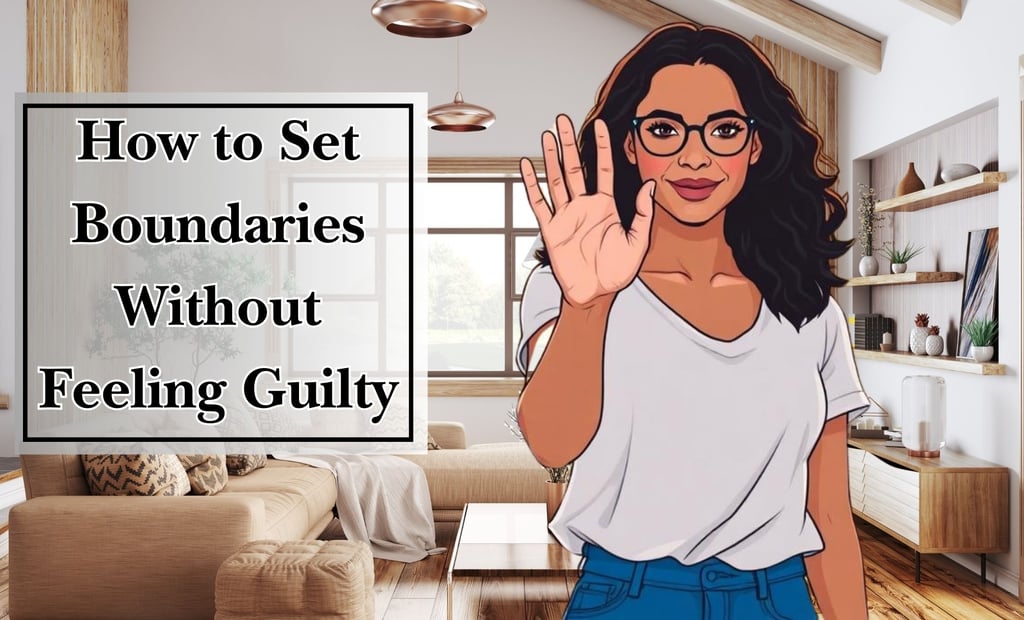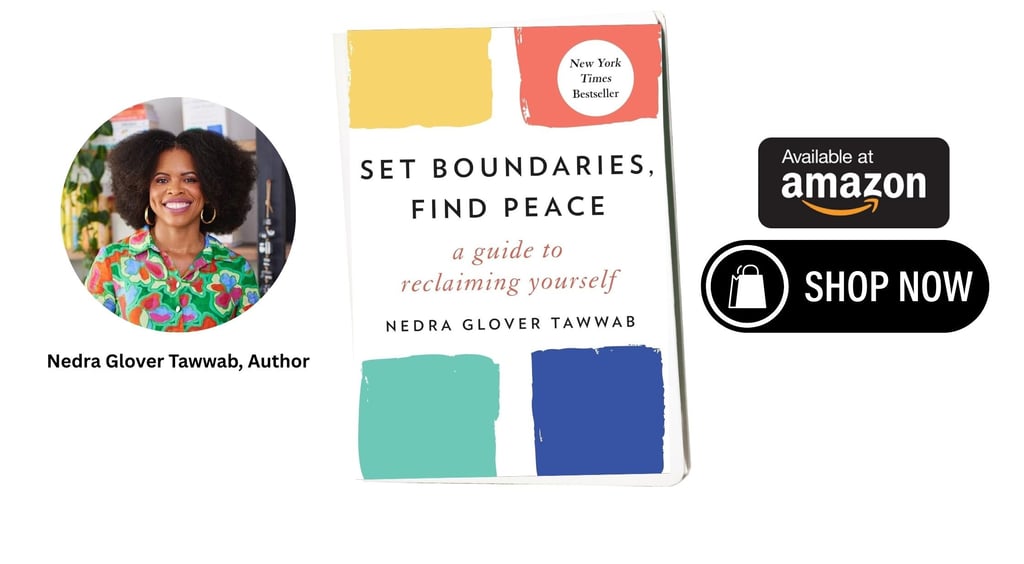How to Set Boundaries Without Feeling Guilty: A Compassionate Guide for Women [2025]
Discover real steps for how to set boundaries without feeling guilty as a woman. Find the gentle support you need to claim your space with confidence.
RELATIONSHIPS
Shari Smith
5/11/202512 min read
As an Amazon affiliate, we earn commissions at no extra cost to you if you click our links and make a purchase.


Setting boundaries can feel hard, especially when guilt sneaks in.
For many of us, saying no or drawing a line brings a knot to the stomach—a mix of duty, fear, or the old habit of putting others first.
Sometimes, it can feel like your needs are a burden.
But learning how to set boundaries without feeling guilty is possible, and it doesn’t mean you care less.
It means honoring yourself while still showing up with care for others.
In this post, you'll find gentle, practical ways to build your own boundaries without shame—so you can create space for what truly matters and find a new sense of freedom and belonging.
Understanding the Need for Boundaries
We all have moments when we know we need to speak up for ourselves, but something inside holds us back.
Boundaries are the invisible lines we draw—lines that help us protect our energy, honor our feelings, and prevent burnout.
For women especially, setting these lines can feel like a small act of rebellion against old habits and expectations.
But in reality, boundaries are our strongest acts of self-respect.


Many women grow up learning that their needs should come last. We say yes, even when our heart aches for a no.
Without clear boundaries, the days blur together in an endless cycle of giving and resentment.
Knowing how to set boundaries without feeling guilty is more than self-care—it’s a way to reclaim your mental and emotional space.
Types of Boundaries Women Commonly Need
Boundaries aren’t one-size-fits-all. Think of them as different types of fences that keep your garden safe and blooming.
Here are some of the most common types women need in everyday life:
Emotional boundaries: Protecting your feelings and choosing when to share personal thoughts. This might look like telling a friend you’re not able to listen to their worries today, or keeping certain memories just for yourself.
Physical boundaries: Deciding who can touch you, enter your personal space, or even borrow your things. It could be as simple as not wanting a hug or needing alone time in your own home.
Time-related boundaries: Guarding your calendar and making sure you aren’t stretched too thin. Saying “I can’t take on another project right now” or carving out quiet time for yourself are practical examples.
Digital boundaries: Managing how and when others can reach you online. Maybe you silence notifications after 8 p.m. or ask loved ones not to share your photos on social media.
Each of these boundaries helps women stay true to who they are, instead of bending until they break.
When you learn how to set boundaries without feeling guilty, you start to nurture yourself in a way that feels safe, steady, and honest.
Why Guilt Often Accompanies Boundary Setting for Women
Even when we know boundaries are healthy, that old feeling of guilt can hit hard.
Women are often taught—sometimes without a single word—that their role is to take care of everyone else first.
This message sneaks in through family traditions, TV shows, conversations at work, and cultural stories passed down through generations.
Many of us grow up with people-pleasing habits. Pleasing others becomes second nature, a secret rulebook we follow to win love and avoid conflict.
When a woman finally tries to draw a line, it can feel like she’s breaking the rules or risking being seen as “selfish.”
That twinge of guilt is less about what you actually want and more about what you think you’re allowed to want.
Societal expectations: Women often feel pressure to be helpers and caretakers 24/7.
Internalized beliefs: From a young age, many girls hear messages telling them to be “nice” and put others first.
Fear of disapproval: Saying no or asking for space may trigger worry about angering loved ones, losing connection, or looking “difficult.”
These factors all swirl together, making boundary setting feel heavy with guilt. But guilt doesn’t mean your need for boundaries is wrong.
It's just a sign you’re unlearning old lessons and giving yourself permission to grow.
Learning how to set boundaries without feeling guilty takes time and kindness.
Each step you take is a chance to honor who you are, without apology.
Recognizing Unhealthy Patterns and Guilt Triggers
Sometimes, it feels easier to ignore the discomfort that creeps in when someone crosses a line.
But spotting those first signs of discomfort is key if you want to learn how to set boundaries without feeling guilty.
When you understand how your mind and body react to boundary violations, it’s like having a map back to yourself.


This section will help you notice the early warning signals and see common moments when guilt tries to take over, especially for women who want to protect their time, energy, and peace.
Identifying Signs of Boundary Violations
Your body and emotions often notice when your boundaries are ignored, even before your mind catches up.
Tuning into these signals can help you protect yourself early, rather than waiting until resentment sets in.
Emotional signs may show up as:
A sudden wave of irritation or frustration, even in small moments
Feeling invisible, overlooked, or taken for granted
Anxiety bubbling up, especially if you anticipate another person’s reaction
Guilt or shame, especially after saying no or expressing a need
Physical signs often appear as:
A tight jaw, stiff shoulders, or clenched fists
Headaches, stomach aches, or a tired, heavy feeling
Restlessness that makes it hard to sit still or focus
Wanting to escape the situation—either by withdrawing or checking out
Behavioral signs show in the ways you act or speak:
Saying “yes” when you want to say “no” just to avoid conflict
Making excuses for someone else's behavior, even when it hurts you
Putting off your own plans or needs out of worry or obligation
Getting snappy or distant with people you care about
If you notice these patterns cropping up, it’s not a personal flaw—it’s a sign your boundaries need attention.
By recognizing these clues, you practice honoring yourself, even in the smallest ways.

How to Set Boundaries (Without Feeling Guilty)
Watch Video...
Common Situations Where Women Struggle with Guilt
Women often run up against guilt in everyday moments. These guilt triggers can sneak up on you—especially during times when you’re trying to set new boundaries.
Here are some familiar situations that bring guilt to the surface:
Saying no at work: Declining a new project or after-hours request, even when your plate is already full, can make you feel selfish or ungrateful. But overcommitting drains your energy and leaves you running on empty.
Family demands: Maybe relatives expect you to host every holiday or drop everything to help. Turning down these requests or asking for help might spark feelings of guilt, even if you genuinely need a break.
Prioritizing self-care: Telling others you can’t meet because you need quiet time or a day off can bring on pangs of guilt. The message that taking care of yourself is “lazy” or “indulgent” runs deep, but it simply isn’t true.
Setting boundaries around emotional labor: Whether it’s always being the listener or taking charge of group plans, saying you need a rest from these invisible jobs may feel risky. Yet, your emotional bandwidth deserves protection too.
Other guilt triggers can pop up when:
You choose not to answer messages or calls right away
You ask a partner or friend to respect your alone time
You decide not to lend money or resources you don’t have
These moments aren’t signs that you’re uncaring—they show you’re learning how to set boundaries without feeling guilty.
Every time you notice guilt trying to guilt-trip you into old habits, remind yourself: honoring your needs helps you show up with more presence and love, not less.
Your boundaries are the blueprint for a kinder, more genuine relationship—with yourself and with others.
Strategies for Setting Boundaries Without Feeling Guilty
Learning how to set boundaries without feeling guilty takes practice, but it can change everything.
When you treat your needs with the same respect you give to others, you give yourself permission to breathe, reset, and show up fully in your life.
Setting boundaries doesn’t have to mean a wall—think of them as gentle fences that protect your peace, energy, and well-being.


With a few mindset shifts and simple tools, you can start feeling more comfortable in your own skin and less weighed down by guilt.
Reframing the Perception of Boundaries
Old stories may say that boundaries are selfish or cold. But those stories miss the point. Healthy boundaries are acts of kindness—both to yourself and to others.
When you’re clear about what you need, you give others a chance to show up and support you in real ways.
Boundaries are a form of self-respect. You can’t pour from an empty cup. By saying no or stepping back when needed, you keep your own well topped up.
Boundaries create honest relationships. When you share your real limits, you invite more honesty from those around you.
Boundaries protect against burnout. Instead of resentment, you create space for joy and connection.
Try this gentle shift in thinking: Boundaries are not barricades; they’re invitations to love yourself. When you say, “I need a break,” you’re not shutting people out.
You’re letting your own light stay bright so you can share it longer.
Effective Communication Techniques
Knowing what you need is one thing. Saying it out loud can feel intimidating. But when you prepare your words and practice, you’ll find it gets easier, step by step.
Here are a few tried-and-true ways to speak your boundaries with confidence:
1. Use clear, “I” statements.
“I need time to rest this weekend, so I can’t commit to plans.”
“I feel overwhelmed when I get calls after 9 p.m. Can we connect earlier?”
2. Keep it short and direct.
Less is often more. You don’t have to over-explain or apologize for taking care of yourself.
“I’m not available to help this time.”
“That doesn’t work for me.”
3. Practice calm, steady tone.
Take a breath before you respond. You might even jot down your words ahead of time if that helps steady your nerves.
4. Repeat if needed.
People may push back. That doesn’t mean you have to bend.
“I understand, but this is what I need.”
“I hear you. My answer is still no.”
5. Express warmth or appreciation where possible.
“I care about our relationship and want to be honest with you.”
“Thanks for understanding my need for downtime.”
You might want to use this simple script next time you feel pressured: “Thank you for thinking of me. I can’t help this time, but I hope your project goes well!”
When you practice these conversations—even out loud alone—they become familiar and less scary. Remember, you’re not responsible for other people’s feelings about your boundaries.
Building Self-Compassion and Confidence
Guilt often creeps in when you doubt your own right to rest, say no, or ask for space. Building self-compassion gives you a strong foundation for change.
Practical tips to nurture self-worth and reinforce your right to boundaries:
Check your self-talk. Notice if the voice in your head says, “I’m selfish” or “I should do more.” Pause and replace it with, “My needs matter, too,” or “It’s okay to rest.”
Remind yourself that everyone has limits. Even the most generous people need care and quiet time to recharge. This is normal and healthy.
Celebrate small wins. Each time you set a simple boundary or speak up, take a moment to honor your courage—even if it feels shaky at first.
Practice self-soothing. Try a hand on your heart with a few slow breaths, or write yourself a note: “I am worthy of kindness, even from myself.”
Surround yourself with support. Connect with friends or communities who value boundaries. Their encouragement can help quiet any leftover guilt.
You might use this simple exercise:
Write down three things you need each week to feel balanced.
Next to each need, jot one way you can honor it—no matter how small.
Practice saying your needs out loud to yourself in the mirror to start believing you deserve them.
The more you practice these small steps, the more your self-compassion will grow.
With time, setting boundaries becomes less about defense and more about self-love.
As you keep showing up for yourself, that old guilt starts to fade, leaving room for freedom, peace, and joy.
Navigating Pushback and Maintaining Your Boundaries
When you start to put boundaries in place, it can feel like you’re learning to walk a new path through an old, tangled forest.
People may react with surprise, disappointment, or even anger.
Their responses aren’t always about you—they’re often about their own routines or fears.
This is a normal part of learning how to set boundaries without feeling guilty.


Staying steady, even when others push back, helps you protect your peace and grow more rooted in your own values. This section covers how to respond with strength and kindness, and what to do when guilt sneaks in afterward.
Anticipating and Responding to Resistance
It’s common to face resistance when you set boundaries with people who aren’t used to them. They may question your choices, press for explanations, or test your limits. Preparing yourself ahead of time makes these moments less overwhelming.
Think of it like building a fence in your garden—some folks may try to peek over or open the gate. You get to decide who comes in and how you respond.
Here’s how you can prepare for pushback and answer with clarity and heart:
Visualize possible reactions: Try to picture how others might respond. Will they be disappointed or try to guilt-trip you? Preparing ahead of time keeps you from feeling caught off guard.
Stay calm and steady: When someone reacts with frustration or questions your decision, keep your voice even. Take a breath before replying so you don’t react out of habit.
Use simple, kind language: Repeat your boundary as needed, without getting pulled into debate. You can say,
“I understand this is hard to hear, but I can’t do that right now.”
“I know this change is new, but it’s what I need.”
If someone ignores your boundary:
Restate it calmly.
Walk away if the conversation gets heated.
Remind yourself they are responsible for their own feelings.
It’s not your job to convince others why your needs matter. You’re allowed to say no and step back, even when someone pushes against the line you’ve drawn.
A few reminders you can keep in your back pocket:
You are not being unkind. Setting boundaries shows respect for yourself and the other person.
You deserve your own space. You don’t need to over-explain.
You can be steady and gentle at the same time. Your needs matter.
Self-Care Practices When Guilt Creeps In
Even with practice, guilt can sneak up after drawing a boundary—especially if someone reacted strongly.
That heaviness can feel like a storm cloud hanging over your decision. Self-care helps you find your center again and turn guilt into gentle self-support.
Here are a few ways to care for yourself when guilt tries to move back in:
Reflect in a quiet moment: Find a peaceful spot and remind yourself why you set the boundary. It’s okay to revisit your reasons and check if they still feel true.
Journal your feelings: Writing down what happened and how you feel can help you untangle guilt from old habits or stories. Sometimes you’ll spot patterns, like always feeling guilty with certain people or in certain situations.
Reach out for support: Call a friend or mentor who understands the journey you’re on. Sometimes, a short talk with someone who “gets it” can ease the tightness in your chest.
Practice self-compassion: Place your hand over your heart or repeat a kind phrase, such as, “I’m allowed to take care of myself,” or “I can feel guilt and still hold my boundaries.”
Remember your why: Jot down your reasons for setting the boundary on a sticky note. Keep it where you’ll see it—your bathroom mirror, purse, or bedside table.
If guilt feels overwhelming, try this:
Pause and take three slow, deep breaths.
Remind yourself: “I am learning. It’s okay to feel this way.”
Talk to yourself the way you’d comfort a good friend.
Over time, these small acts help you rebuild trust in yourself. The guilt loses its grip, and you start to feel the ground beneath your feet again.
Learning how to set boundaries without feeling guilty takes steady practice, but each act of self-care brings you closer to ease and freedom.
Conclusion
Setting boundaries without feeling guilty is an act of quiet bravery—a gentle promise to honor yourself in a world that may ask you to shrink.
You don’t have to do it all at once. Even the smallest step is a start. As you practice, guilt will show up less often, and your voice will feel steadier.
Remember: your boundaries are not only allowed—they’re needed. They let you show up with more presence, kindness, and honesty, both for yourself and those you love.
If you’ve spent years saying yes when you wanted to say no, now is the perfect time to begin shifting that story.
Thank you for sharing this space and time. If you’re ready, pick one boundary to try this week—starting small counts.
I hope you’ll share your thoughts or pass these words along to someone else who needs to hear they’re not alone.
Every bit of progress matters, and you’re right where you need to be.






